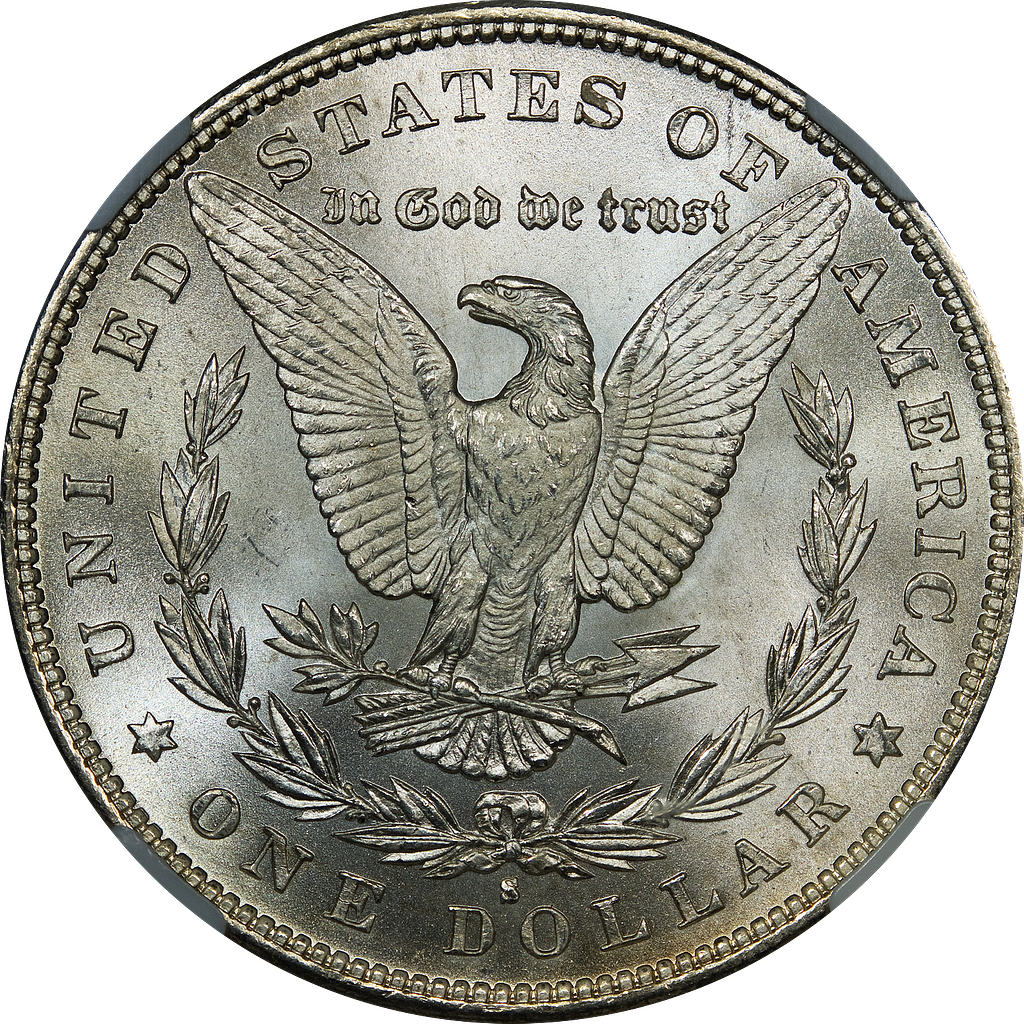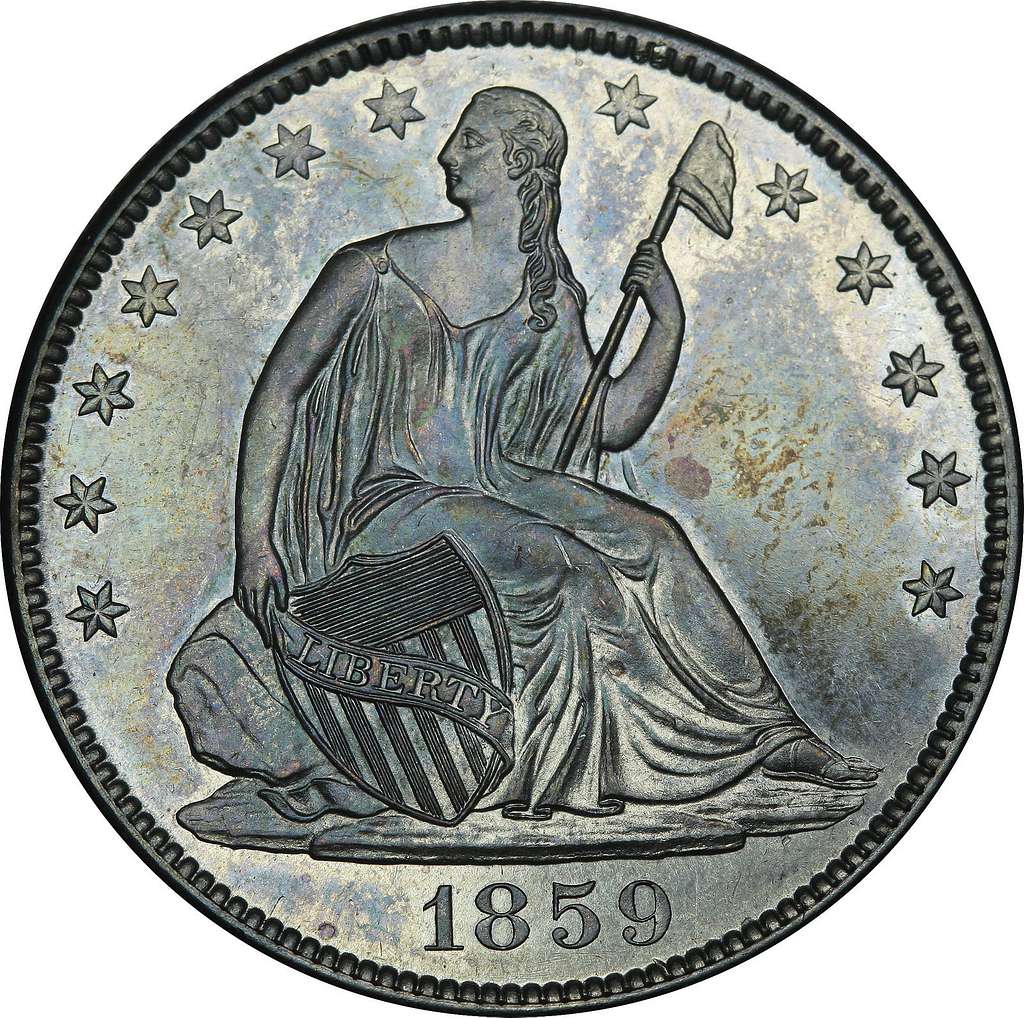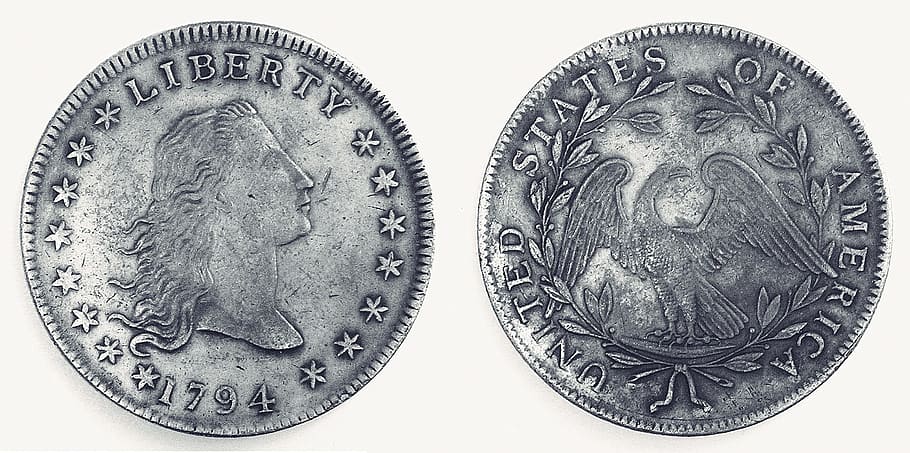Silver Dollar Value

Silver dollars have been used for thousands of years to store value and facilitate trade. The Ancient Egyptians actually considered silver to be more valuable than gold because of how scarce the precious metal was in their homeland. In the United States, dollar coins have never been popular. Americans tend to prefer to use paper $1 notes for trade and barter, despite the U.S. Treasury’s growing stockpile of dollar coins.
Modern silver dollars aren’t actually made using silver at all. Since 1971, silver dollars in the United States are actually ‘clad’ coins. Pure copper bullion fills the inside of each dollar coin, while copper and nickel give an outer appearance that resembles silver.
But before 1971, the U.S. Mint’s silver dollars were made using .90 fine silver. While the coins may have failed to catch on as a genuine form of currency for trade, they’ve become a premier investment vehicle for collectors all over the world. Today, we’re covering silver dollar values to help new and seasoned bullion enthusiasts better understand how these numismatic coins might fit into their own silver portfolios.
Evaluating Silver Dollar Value
Silver dollar values are primarily determined by their melt silver value. While some silver dollars have quite a bit of numismatic or collectable value, others are really only worth their silver bullion content. Below, we’ll cover the two main factors used to determine silver dollar values: condition and rarity.
How does Condition Affect Silver Dollar Worth?

The condition of a coin will always impact its total value. Newer coins from the late 1960s might be common to find in decent condition, but much older coins will most frequently be seen in poor, heavily circulated condition. Take the Flowing Hair Dollar as an example. This coin was only minted during 1794-95, making it both very old and exceedingly rare. The rarest Flowing Hair Dollars might be worth a million dollars or more!
If you plan on collecting silver dollars, make sure to keep them in peak condition for as long as possible. Your silver dollar’s value will begin to decline if you allow the coin to become damaged or weathered over time. Condition remains an important element used to determine silver dollar values.
Rarity as a Key Factor
While the condition of a silver dollar can be tough to judge unless you use a professional coin grading service, online guides make it easy to judge the rarity of a given coin. Silver dollar value for a coin depends primarily on its rarity. Some coins were minted in such low numbers that virtually none exist – especially in excellent condition.
Some silver dollars, such as the Gobrecht Dollar, are considered extremely rare regardless of minting year. Other silver coin values are highly variable. Morgan Dollars, for example, can range in silver dollar value from $32 to over $500,000.
Rarity isn’t just about year, either. Mint marks are used to denote the mint that produced a coin. Silver dollar values for coins like the Peace Dollar can vary based on their mint marks. Morgan Dollars produced in the remote Carson City Mint tend to be more valuable than similar coins from the Philadelphia Mint, for example.
Certain errors can also increase the numismatic silver dollar value of a coin. Some specific errors can make coins worth hundreds of thousands of dollars. To spot the most valuable errors that influence silver dollar values, familiarize yourself with leading coin magazines and databases.
Factors Influencing Value
We’ve already discussed two main factors used to determine silver dollar values. In this section, we’ll talk about how silver spot price, historical significance, and supply and demand economics result in fluctuating silver dollar values.
Precious Metal Content and Silver Spot Price
Silver content is the easiest silver dollar value component to measure. The spot price of silver directly correlates with the melt value of a silver dollar. In a way, silver’s spot price makes up the base value of a silver dollar. When you add factors like condition and rarity onto the melt value of the silver a coin contains, you can determine the total silver dollar value for your collectible piece.
Smart investors track the spot price of silver to determine the value of their investments. Whether you plan on buying a classic American Silver Eagle or a circulated silver dollar, the spot price of silver helps to determine the base cost of your investment.
Historical and Numismatic Significance
Certain silver dollars occupy exceptionally important moments in American history. The Flowing Hair Dollar was the first silver dollar minted by the United States and was distributed very shortly after the end of the American Revolution. This means the coin represents an essential time in the history of American coinage and culture.
Coins minted during significant time in bullion history are generally very rare. During historical silver shortages, silver dollars might have been minted in extraordinary quantities. This results in a series of coins that is both rare and historically significant.
Supply and Demand Dynamics
Supply and demand are basic laws of economics, and these laws apply to bullion products just like they do to stocks or other correlated assets. Silver dollar values are partially determined by demand, as well as supply. We mentioned above that silver shortages might result in very few of a given coin being distributed for circulation. This results in a diminished supply. If demand remains high but supply decreases, silver dollar values tend to increase.
Even centuries after the initial release of a silver dollar, its silver dollar value might be reliant on supply and demand. Demand for silver dollars can wax and wane depending on a number of factors. Investors might become more interested in old silver dollars when commemorative bullion editions of these coins are released, for example.
Types and Varieties
There are several types of silver dollars available on the market. Before putting your money on silver dollars, think about how different types of coins result in various silver dollar values. We’ll take a look at five silver dollars below: Morgan Dollars, Peace Dollars, Trade Dollars, Seated Liberty Dollars, and Flowing Hair Dollars.
Morgan Dollars

Morgan Dollars are the most common silver dollar coins available. While silver dollar values for Morgans can be high, many Morgan Dollars are only worth their spot value in silver. The 1921 Morgan Silver Dollar is considered the most common silver dollar from the U.S. Mint. It’s estimated that almost 90,000,000 Morgan Dollars were minted in 1921. This means their supply is high, which diminishes silver dollar value for this piece.
Some Morgan Dollars, however, are extremely rare. Both condition and rarity are important elements used to determine silver dollar values for Morgan Dollars. Certain rare errors can result in Morgan Dollars that are worth tens of thousands of dollars or more.
Peace Dollars
Peace Dollars were minted right after the discontinuation of Morgan Silver Dollars in 1921. Like the name suggests, Peace Dollars were meant to commemorate the peace enjoyed by the United States after World War I concluded.

At the high end, even the rarest Peace Dollars don’t offer the silver dollar values provided by rare Morgan Silver Dollars. Still, certain major errors or exceptionally rare Peace Dollars can be very expensive. Peace Dollars also carry significant historical value; these coins offer beautiful designs that invoke an important period of American history.
Trade Dollars

Even the most common Trade Dollars carry significant numismatic value. The beautiful seated liberty design of this coin is a continuation of similar artwork used on the obverse of the Liberty Seated Dollar, which stopped production in 1873. The coin also features a reverse-side design of a flying eagle carrying arrows and an olive branch, a design popularized again in the Morgan Dollar.
On the low end, Trade Dollars are worth over a hundred dollars each. Their extreme historical significance and collectable value makes them a favorite for historically-oriented collectors, and the pure silver increases the silver dollar value of these coins.
Seated Liberty Dollars
Seated Liberty Dollars are the predecessors to Trade Dollars. Both coin designs feature a seated Lady Liberty on the obverse and an eagle on the reverse. The reverse-side bald eagle on the Seated Liberty wears a shield of the United States on its chest, adding another layer of American symbolism to the cultural imagery of the coin.

Seated Liberty Silver Dollar values can vary significantly based on rarity, condition, and market demand. Certain errors increase value greatly; some rare versions of the coin can fetch over $70,000 at auction.
Flowing Hair Dollars
The Flowing Hair Dollar is where silver dollar coinage in the U.S. begins. The coin was first made in 1794, which would have been less than twenty years after the conclusion of the bloody American Revolution. The coin’s designs aren’t quite as detailed as modern American bullion coins, which shouldn’t be surprising, considering how old these coins really are.

On the absolute low-end, Flowing Hair Dollars sell for thousands of dollars. The most expensive Flowing Hair Dollar ever sold was purchased in near-uncirculated condition for a whopping $1,500,000 at auction. There’s a reason why silver dollar values are so expensive; their unique place in American history, combined with pure silver content and beautiful antique designs, makes them an exceptional addition to your silver portfolio.
Determining Value
If you feel that silver dollars might be a good way to expand your portfolio, you’ll need to determine a strategy for assessing silver dollar values. Luckily, there are hundreds of resources online that can help you get a better idea of what your silver dollars might be worth.
Online Price Guides and Databases
The Professional Coin Grading Service offers an online database that can help people determine silver dollar values. If you spend some time shopping around and researching, you’ll find countless other tools that can help you make sense of the thousands of coins available on the bullion market. Determining silver dollar values shouldn’t be difficult, and we’re pretty satisfied with the number of databases and guides available online.
Make sure you look for databases that provide evidence for their price estimates. The last thing you want is to leave the sale of your coins in the hands of someone who’s just guessing at a price estimate. Some coin value databases also make money from affiliate marketing; make sure you check other retailers before buying a coin using the link provided to you from a coin grading company.
Professional Appraisal Services
Especially if you have a coin with exceptionally high silver dollar value on your hands, professional coin grading may be a sound financial decision. When you get a coin graded by a professional agency, you’ll receive a certificate verifying both the legitimacy and the condition of your coin. This looks great to potential buyers; you’ll almost never see a high-ticket bullion item sold at auction without some sort of professional grading.
When shopping around for professional grading agencies, make sure to read reviews to get a better idea of the company’s reputation. Grading agencies are stamping their seal of approval onto your coin. If their reputation among buyers isn’t great, then it won’t do you much good to have your coin professionally graded by them.
Numismatic Communities and Forums
Forums are also a great place for you to get estimates for silver dollar values. By putting time into getting to know other people on a popular coin forum, you can start networking with different dealers and coin buyers. It may seem like a small step, but establishing a working relationship with people in the industry can help you find better deals and more accurate value estimates for coins you might come across.
Some forums even offer ‘price check’ subforums, where you can post the details of your coin to get estimates from some of the seasoned investors on the site. We recommend taking price checks with a grain of salt; leave silver dollar valuation to the professionals if you’re dealing with an especially valuable piece.
Tips for Collectors and Investors
Silver dollars can be one part of a diversified precious metals investment strategy. If you’ve been stacking using classic bullion coins like the Canadian Silver Maple, adding a coin with numismatic and collectors value might help you maintain profitability – even during silver bear markets.
Considerations for Buying and Selling
If you’ve settled on buying silver dollars for your portfolio, your journey won’t end at determining silver dollar values. Instead, smart investors take active steps to protect themselves during the entire lifespan of their investment, from purchase to eventual sale.
When you search for the right coin to buy, do your research. Always look into the premiums being charged over spot by each bullion dealer you do business with. Legitimate dealers should be up-front and honest about premium fees. Hidden charges are never fun for investors to deal with, which is why Hero Bullion clearly displays our precious metal product prices on each page of our site.
Building a Valuable Collection
To build a collection with high silver dollar value, you’ll want to diversify. Yep – the golden rule of traditional investment also has its place in precious metals trading. Buying coins from various time periods can help to ensure collectable value despite shifts in market sentiment and demand. We recommend combining lower-value coins with more expensive ones to keep your portfolio diverse and healthy.
It’s also a good idea to mix silver investment with other precious metals. The silver market is extremely volatile. Countering the volatility of silver with another precious metal like platinum or gold can help you to fight back against wild market fluctuations. Gold and platinum bullion coins are a great way to accomplish this goal.
Long-Term Investment Potential
Long-term investment potential should be a prime concern when you consider investing in silver dollars. Silver dollar values fluctuate over time, but they serve as excellent long-term investment vehicles. The main reason why is that these coins naturally become more scarce as time passes. While new American Silver Eagles are produced each year and add to the total market supply, there will never be another 1878 Morgan Silver Dollar distributed by the U.S. Mint.
Consider your investment time horizon before diving into silver dollar investments. Silver dollars are often considered long-term investments. They don’t offer the high silver purity of bullion coins, meaning that it’s harder to profit from them in the short term when the price of silver hits a new high. Still, creative investors often have highly developed ideas of their personal time horizons, meaning that they can include various types of silver products without straying from the plan.
Final Thoughts: Silver Dollar Value Explained
Though modern silver coinage isn’t actually silver at all, the .90 silver dollars from early American history have become favorite investments for silver collectors all over the world. Silver dollar values can vary significantly. Some silver dollars are worth only their spot price in silver, while others are worth thousands – or millions – of dollars.
Before you buy silver dollars, you should understand how these coins are evaluated. Rarity, condition, and the spot price of silver determine the value of a silver dollar.
About The Author
Michael Roets
Michael Roets is a writer and journalist for Hero Bullion. His work explores precious metals news, guides, and commentary.
